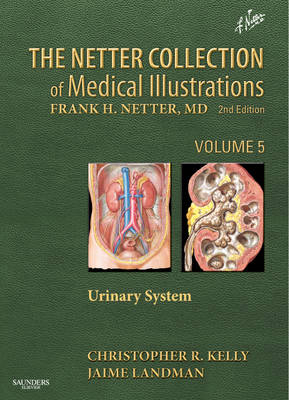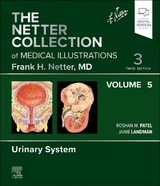
Netter Collection of Medical Illustrations - Urinary System
Saunders (Verlag)
978-1-4377-2238-3 (ISBN)
"The Urinary System, 2nd Edition" provides a concise and highly visual approach to the basic sciences and clinical pathology of the kidney, bladder, and ureters. This volume in "The Netter Collection of Medical Illustrations" (the CIBA "Green Books") has been expanded and revised by Drs. Christopher Rehbeck Kelly and Jaime Landman to capture current clinical perspectives in nephrology and urology - from normal anatomy, histology, physiology, and development to glomerular and tubular diseases, infections, urological surgeries, and cancers. It also features hundreds of radiologic and pathologic images to supplement the classic Netter illustrations, as well as new illustrations created.
Section 1 - ANATOMY OF THE URINARY TRACT * Kidney: Position and Relations (Anterior View) * Kidney: Position and Relations (Posterior View) * Kidney: Position and Relations (Transverse Sections) * Kidney: Gross Structure * Renal Fascia * Ureters: Position, Relations, Gross Structure * Bladder: Position, Relations, Gross Structure (Male) * Bladder: Position, Relations, Gross Structure (Female) * Bladder: Position, Relations, Gross Structure (Coronal Cross-Section) * Renal Vasculature: Renal Artery and Vein In Situ * Renal Vasculature: Renal Artery Segmental Branches and Intrarenal Arteries * Renal Vasculature: Variations in Renal Artery and Vein * Vasculature of Ureters and Bladder * Innervation of Kidneys, Ureters and Bladder * Innervation Pathways of the Kidneys and Upper Ureter * Innervation Pathways of the Ureter and Bladder * Lymphatics of Urinary System * Overview of the Nephron * Renal Microvascualture * Glomerulus: Structure and Histology * Glomerulus Fine Structure * Glomerulus: Electron Microscopy * Proximal Tubule * Thin Limb * Distal Tubule * Collecting Duct * Renal Pelvis, Ureter, and Bladder Section 2 - Normal and Abnormal Development * Development of Kidney * Development of Kidney: Nephron Formation * Development of Bladder and Ureter: Formation of the Cloaca * Development of Bladder and Ureter: Septation, Incorporation of Ureters, and Maturation * Renal Ascent and Ectopia: Normal Renal Ascent and Pelvic Kidney * Renal Ascent and Ectopia: Thoracic and Crossed Ectopic Kidney * Renal Rotation and Malrotation * Anomalies in Number of Kidneys: Bilateral Renal Agenesis * Anomalies in Number of Kidneys: Unilateral Renal Agenesis * Anomalies in Number of Kidneys: Supernumerary Kidney * Renal Fusion * Renal Dysplasia * Renal Hypoplasia * Simple Cysts * Polycystic Kidney Disease: Gross Appearance * Polycystic Kidney Disease: Radiographic Findings * Medullary Sponge Kidney * Nephronophthisis / Medullary Cystic Kidney Disease Complex * Retrocaval Ureter: Radiographic Findings and Laparoscopic Repair * Retrocaval Ureter: Normal Development of the Inferior Vena Cava * Vesicoureteral Reflux: Mechanism and Grading * Vesicoureteral Reflux: Voiding Cystourethrograms * Ureteral Duplication: Complete * Ureteral Duplication: Incomplete * Ectopic Ureter * Ureterocele: Gross and Fine Appearance * Ureterocele: Radiographic Findings * Prune Belly Syndrome: Appearance of Abdominal Wall * Prune Belly Syndrome: Appearance of Kidneys, Ureters, and Bladder * Epispadias Exstrophy Complex: Epispadias * Epispadias Exstrophy Complex: Bladder Exstrophy * Bladder Duplication and Septation * Anomalies of the Urachus * Posterior Urethral Valves: Gross Appearance * Posterior Urethral Valves: Radiographic Findings Section 3 - Physiology * Basic Functions and Homeostasis * Clearance and Renal Plasma Flow * Glomerular Filtration Rate * Glomerular Filtration Rate: Calculation * Secretion and Reabsorption: Tubular Reabsorption and Saturation Kinetics * Secretion and Reabsorption: Fractional Excretion (Clearance Ratios) * Renal Handling of Sodium and Chloride: Nephron Sites of Sodium Reabsorption * Renal Handling of Sodium and Chloride: Response to Extracellular Fluid Contraction * Renal Handling of Sodium and Chloride: Response to Extracellular Fluid Expansion * Renal Handling of Potassium * Renal Handling of Calcium, Phosphate, and Magnesium * Countercurrent Multiplication: Model - Part 1 * Countercurrent Multiplication: Model - Part 2 * Countercurrent Multiplication: Models to Demonstrate Principle of Countercurrent Exchange System of Vasa Recta in Minimizing Dissipation of Medullary Osmotic Gradient * Urine Concentration and Dilution: Long-Looped Nephron (ADH Present) * Urine Concentration and Dilution: Long-Looped Nephron (ADH Absent) * Antidiuretic Hormone * Tubuloglomerular Feedback and Modulation of Renin Release * Tubuloglomerular Feedback and Renin-Angiotensin-Aldosterone System * Acid Base Balance: Roles of Chemical Buffers, Lungs, and Kidneys in Acid-Base Handling * Acid Base Balance: Renal Bicarbonate Reabsorption * Acid Base Balance: Renal Bicarbonate Synthesis and Proton Excretion * Acid Base Balance: Acidosis and Alkalosis * Additional Functions of Erythropoiesis and Vitamin D * Renal Tubular Acidosis: Proximal * Renal Tubular Acidosis: Classic Distal * Nephrogenic Diabetes Insipidus: Diabetes Insipidus * Nephrogenic Diabetes Insipidus: Major Causes and Symptoms Section 4 - Renal Diseases * Overview of Acute Kidney Injury: Causes * Overview of Acute Kidney Injury: Possible Urine Findings * Acute Tubular Necrosis: Causes, Pathophysiology, and Clinical Features * Acute Tubular Necrosis: Histopathological Findings * Overview of Nephrotic Syndrome: Pathophysiology * Overview of Nephrotic Syndrome: Causes * Overview of Nephrotic Syndrome: Presentation and Diagnosis * Minimal Change Disease: Causes and Presentation * Minimal Change Disease: Histopathology * Focal Segmental Glomerulosclerosis: Causes, Clinical Features, and Histopathological Findings * Focal Segmental Glomerulosclerosis: Histopathological Findings (Continued) * Membranous Nephropathy: Causes and Clinical Features * Membranous Nephropathy: Histopathological Findings * Overview of Glomerulonephritis: Clinical Features and Histopathological Findings * Overview of Glomerulonephritis: Histopathological Findings (Continued) * IgA Nephropathy: Causes and Clinical Features * IgA Nephropathy: Histopathological Findings * IgA Nephropathy: Histopathological Findings (Continued) * Post-infectious glomerulonephritis: Causes and Clinical Features * Post-infectious glomerulonephritis: Histopathological Findings * Post-infectious glomerulonephritis: Histopathological Findings (Continued) * Membranoproliferative glomerulonephritis: Causes, Features, and Assessment * Membranoproliferative glomerulonephritis: Classical Pathway of Complement Pathways * Membranoproliferative glomerulonephritis: Histopathological Findings * Rapidly progressive glomerulonephritis * Hereditary Nephritis (Alport's) / Thin Basement Membrane Nephropathy: Pathophysiology and Clinical Features * Hereditary Nephritis (Alport's) / Thin Basement Membrane Nephropathy: Electron Microscopy Findings * Acute Interstitial Nephritis: Causes and Clinical Features * Acute Interstitial Nephritis: Histopathological Findings * Chronic Tubulointerstitial Nephritis and Analgesic Nephropathy * Chronic Tubulointerstitial Nephritis: Histopathological Findings * Thrombotic Microangiopathy: General Features * Thrombotic Microangiopathy: Hemolytic-Uremic Syndrome * Thrombotic Microangiopathy: Thrombotic Thrombocytopenic Purpura * Renal Vein Thrombosis * Renal Artery Stenosis: Pathophysiology of Renovascular Hypertension * Renal Artery Stenosis: Causes * Congestive Heart Failure: Types of Left Heart Failure and Effects on Renal Function * Congestive Heart Failure: Effects of Left Heart Failure on Renal Blood Flow and Tubular Function * Hepatorenal Syndrome: Proposed Pathophysiology * Hepatorenal Syndrome: Symptoms and Diagnosis * Chronic and Malignant Hypertension: Major Causes * Chronic and Malignant Hypertension: Renal Histopathology (Chronic) * Chronic and Malignant Hypertension: Renal Histopathology (Malignant) * Diabetic Nephropathy: Diabetes Mellitus * Diabetic Nephropathy * Amyloidosis: Deposition Sites and Manifestations * Amyloidosis: Histopathological Findings * Lupus Nephritis: Diagnostic Criteria * Lupus Nephritis: Renal Histopathology (Class I and II Lesions) * Lupus Nephritis: Renal Histopathology (Class III and IV Lesions) * Lupus Nephritis: Renal Histopathology (Class V Lesions) * Myeloma Nephropathy: Pathophysiology and Clinical Findings * Myeloma Nephropathy: Histopathological Findings * HIV-Associated Nephropathy: Light Microscopy Findings * HIV-Associated Nephropathy: Electron Microscopy Findings * HIV-Associated Nephropathy: Mechanisms of Infection and Antiretroviral Therapy * Preeclampsia: Clinical Definition and Potential Mechanism of Pathogenesis * Preeclampsia: Renal Pathology * Preeclampsia: HELLP Syndrome and Eclampsia * Henoch Schonlein Purpura: Diagnostic Criteria * Henoch Schonlein Purpura: Additional Clinical Features * Fabry's Disease * Cystinosis: Pathophysiology and the Renal Fanconi Syndrome * Cystinosis: Extrarenal Manifestations * Overview of Chronic Kidney Disease: Staging System and Major Causes * Overview of Chronic Kidney Disease: Mechanism of Progression and Complications * Overview of Chronic Kidney Disease: Uremia * Overview of Chronic Kidney Disease: Normal Calcium and Phosphate Metabolism * Overview of Chronic Kidney Disease: Calcium and Phosphate Metabolism in Chronic Kidney Disease Section 5 - Urinary Tract Infections * Cystitis: Risk Factors * Cystitis: Common Symptoms and Tests * Cystitis: Evaluation * Cystitis: Treatment * Pyelonephritis: Risk Factors and Major Findings * Pyelonephritis: Pathology * Bacteriuria Management of Asymptometic Bacteriuria * Intrarenal and Perinephric Abscesses * Tuberculosis: Infection and Extrapulmonary Spread * Tuberculosis: Urinary Tract * Schistosomiasis: Lifecycle of Schistosoma Haematobium * Schistosomiasis: Effects of Chronic Schistosoma Haematobium Infection Section 6 - Urinary Tract Obstructions * Obstructive Uropathy: Etiology * Obstructive Uropathy: Sequelae * Urolithiasis: Formation of Renal Stones * Urolithiasis: Major Sites of Renal Stone Impaction * Urolithiasis: Appearance of Renal Stones * Ureteropelvic Junction Obstruction * Ureteral Strictures Section 7 - Traumatic Injuries * Renal Injuries: Grading System and Renal Parencyhmal Injuries * Renal Injuries: Renal Hilar Injuries * Ureteral Injuries * Bladder Injuries: Extraperitoneal Bladder Ruptures * Bladder Injuries: Intraperitoneal Bladder Ruptures Section 8 -Voiding Dysfunction * Voiding dysfunction: Anatomy of Female Urinary Continence Mechanisms * Voiding dysfunction : Neural Control of Bladder Function and Effects of Lesions * Voiding dysfunction: Stress Urinary Incontinence * Urodynamics: Equipment and Set-up for Urodynamics Studies * Urodynamics: Example Urodynamics Recordings Section 9 - Neoplasms * Benign Renal Tumors: Papillary Adenoma and Oncocytoma * Benign Renal Tumors: Angiomyolipoma * Renal Cell Carcinoma: Risk Factors and Radiographic Findings * Renal Cell Carcinoma: Gross Pathological Findings * Renal Cell Carcinoma: Histopathological Findings * Renal Cell Carcinoma: Staging System and Sites of Metastasis * Wilms Tumor: Genetics, Presentation, and Radiographic Findings * Wilms Tumor: Gross Appearance and Histopathological Findings * Tumors of the Renal Pelvis and Ureter: Risk Factors and Radiographic Appearance * Tumors of the Renal Pelvis and Ureter: Appearance (Ureteroscopic, Gross, and Microscopic) and Staging System * Tumors of the Bladder: Risk Factors, Symptoms, and Physical Examination * Tumors of the Bladder: Cystoscopic and Radiographic Appearance * Tumors of the Bladder: Histopathological Findings and Staging System Section 10 - Therapeutics * Osmotic Diuretics * Carbonic Anhydrase Inhibitors * Loop Diuretics * Thiazide Diuretics * Potassium-Sparing Diuretics * Inhibitors of the Renin-Angiotensin System * Renal Biopsy: Indications and Structure of Typical Spring-Loaded Needle * Renal Biopsy: Procedure * Hemodialysis, Peritoneal Dialysis, and Continuous Therapies: Hemodialysis * Hemodialysis, Peritoneal Dialysis, and Continuous Therapies: Vascular Access for Hemodialysis * Hemodialysis, Peritoneal Dialysis, and Continuous Therapies: Peritoneal Dialysis * Extracorporeal shockwave lithotripsy * Percutaneous nephrolithotomy: Creation of Access Tract * Percutaneous nephrolithotomy: Nephroscope and Sonotrode * Percutaneous nephrolithotomy: Ultrasonic Lithotripsy of Large Stones * Pyeloplasty / Endopyelotomy * Renal Revascularization: Endovascular Therapies * Renal Revascularization: Surgical Therapies * Simple and Radical Nephrectomy: Open Nephrectomy (Incisions for Transperitoneal and Retroperitoneal Approaches) * Simple and Radical Nephrectomy: Open Simple Nephrectomy (Flank Approach) * Simple and Radical Nephrectomy: Laparoscopic Radical Nephrectomy (Transperitoneal Approach (Left-Sided)) * Partial Nephrectomy: Open Partial Nephrectomy (Retroperitoneal (Flank) Approach) * Partial Nephrectomy: Laparoscopic Partial Nephrectomy (Transperitoneal Approach) * Renal Ablation: Laparoscopic Cryoablation (Retroperitoneal Approach) * Renal Ablation: Percutaneous Cryoablation * Renal Transplantation: Recipient Operation * Renal Transplantation: Mechanisms of Action of Immunosuppressive Medications * Renal Transplantation: Causes of Graft Dysfunction in Immediate Post-Operative Period * Renal Transplantation: Causes of Graft Dysfunction in Early Post-Transplant Period * Renal Transplantation: Acute Rejection (Histopathological Findings) * Renal Transplantation: Calcineurin Inhibitor Nephrotoxicity (Histopathological Findings) * Renal Transplantation: Causes of Graft Dysfunction in Late Post-Transplant Period * Ureteroscopy: Device Design and Deployment * Ureteroscopy: Stone Fragmentation and Extraction * Ureter Reimplantation * Ureteral Reconstruction * Cystoscopy: Cystoscope Design * Cystoscopy: Cystoscopic Views * Transurethral Resection of Bladder Tumor: Equipment and Procedure * Transurethral Resection of Bladder Tumor: Procedure (Continued)
| Reihe/Serie | Netter Green Book Collection ; v. 5 |
|---|---|
| Zusatzinfo | Approx. 300 illustrations (300 in full color) |
| Verlagsort | Philadelphia |
| Sprache | englisch |
| Maße | 246 x 297 mm |
| Gewicht | 1320 g |
| Themenwelt | Schulbuch / Wörterbuch ► Lexikon / Chroniken |
| Medizin / Pharmazie ► Medizinische Fachgebiete ► Urologie | |
| Studium ► 1. Studienabschnitt (Vorklinik) ► Anatomie / Neuroanatomie | |
| ISBN-10 | 1-4377-2238-5 / 1437722385 |
| ISBN-13 | 978-1-4377-2238-3 / 9781437722383 |
| Zustand | Neuware |
| Informationen gemäß Produktsicherheitsverordnung (GPSR) | |
| Haben Sie eine Frage zum Produkt? |
aus dem Bereich



